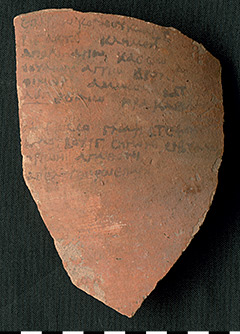SB III 6221 (P. 12682)
Teutons in Egypt? One can hardly imagine that. And yet there are some testimonies from the Roman period that prove the stay of Germanic people in Egypt. One such example is the object presented here. This inconspicuous shard of clay offers evidence of a Germanic woman in Egypt who also had a very special profession.
The ostracon (inscribed clay sherd) was found during Otto Rubensohn’s excavations on the island of Elephantine between 1906 and 1908 and shortly afterwards came into the Berlin Papyrus Collection. This island of Elephantine lies in the middle of the Nile opposite the city of Aswan in southern Egypt. The ostracon contains a text in Greek. The legible writing can be dated to the 2nd century AD.
The content of the text is very banal at first glance – it is a list of names. Such lists of names are often little noticed and little appreciated. This is because the purpose of such lists can rarely be ascertained. Moreover, their context is usually unknown. But there are exceptions, for example when a name in the list catches the eye and prompts further questions. Names can sometimes provide quite important insights. This is also the case with the list on this ostracon.
All the names in this list are in the dative case. One could conclude from this that the persons in this list are to be given something (e.g. money or the like). But this cannot be said for sure, since the context of the list is unknown and there is no further information in the text. It is noticeable, however, that the list has been divided into two parts by a horizontal line between the sixth and seventh line. Above this line, a conspicuous number of Roman names have been listed. Thus, among others, we find the Latin names Clemens, Cassius, Longinus and Iulius – all names, however, were written in Greek script. About the persons in this first group we learn that they were cornicularii, centuriones and actuarii, who were possibly in the personal service of the Roman governor in Egypt. All these terms are rank designations of the Roman army. So it is quite possible that we have here a list of the military staff of the Roman governor in Egypt.
The names listed below the line, however, are even more interesting. In the second group of names that follows here, not a single Roman name appears. Nor is there a military rank designation to be found here. Instead, among others, a freedman of the Roman governor in Egypt and a fuller by the name of Narkissos appear here. The latter is almost certainly a slave, since slave children were often given names from mythology in those days. In Greek mythology, Narkissos was a beautiful youth who fell in love with his own reflection and rejected the love of others. So if the first group of names in this list listed the military staff of the Roman governor, it is quite possible that the second group grouped together his servants.
A special feature, however, is a name in the second group that is neither Egyptian nor Greek nor Latin: Baluburg. The foreignness of this name is already evident from the fact that the scribe did not add a suitable Greek ending for the dative case as he did with all the other names. Apparently he already had enough problems to render the name as he heard it. It is the name Walburg, although very rarely encountered today, but known through the Walpurgis Night.
Of this Walburg we learn that she probably belonged to the Germanic tribe of the Semnones and was a sibyl, a fortune-telling woman. We encounter Germanic fortune-tellers quite frequently in the ancient literary sources. Perhaps the best known is Veleda, who prophesied the victory of the rebellious Germanic tribes during the Batavian Revolt in Germania in 69 to 70 AD. The Walburg on this ostracon possibly came as a prisoner of war to the household of the Roman governor, who – as was common at the time – valued divination. The stranger it was, the better. And so Walburg was certainly also an important member of the governor’s household and accompanied her master to Upper Egypt, where this ostracon was finally found on the island of Elephantine.



